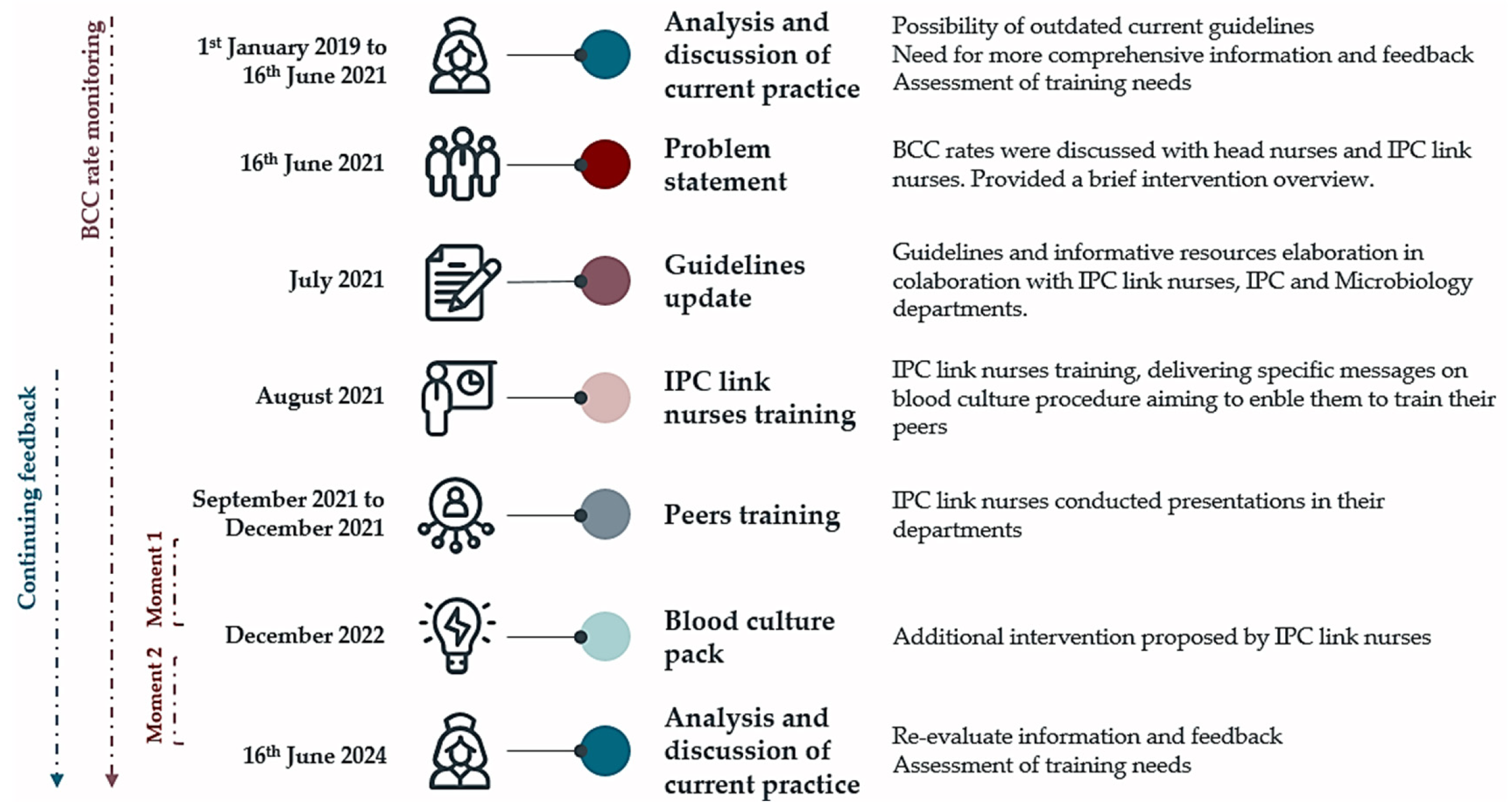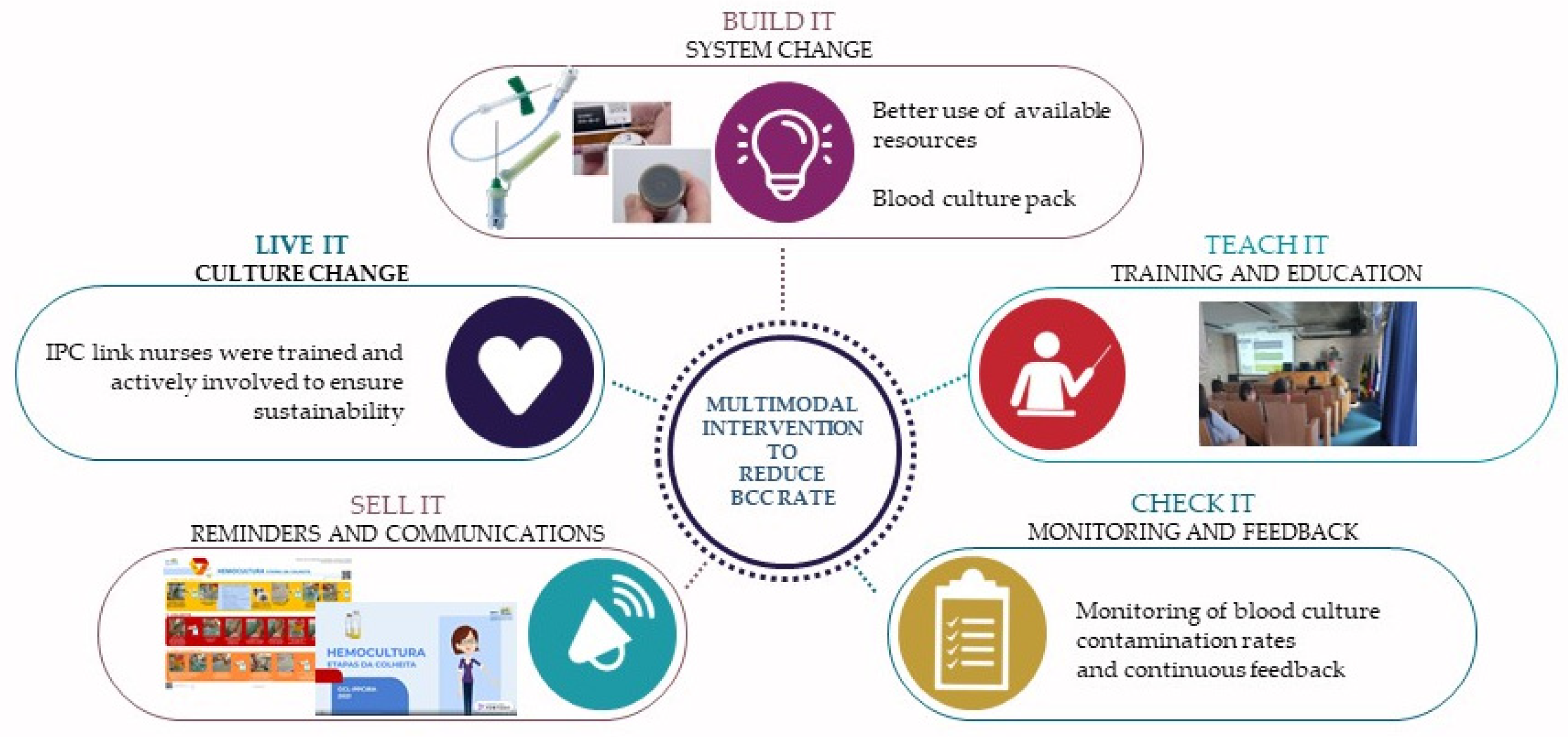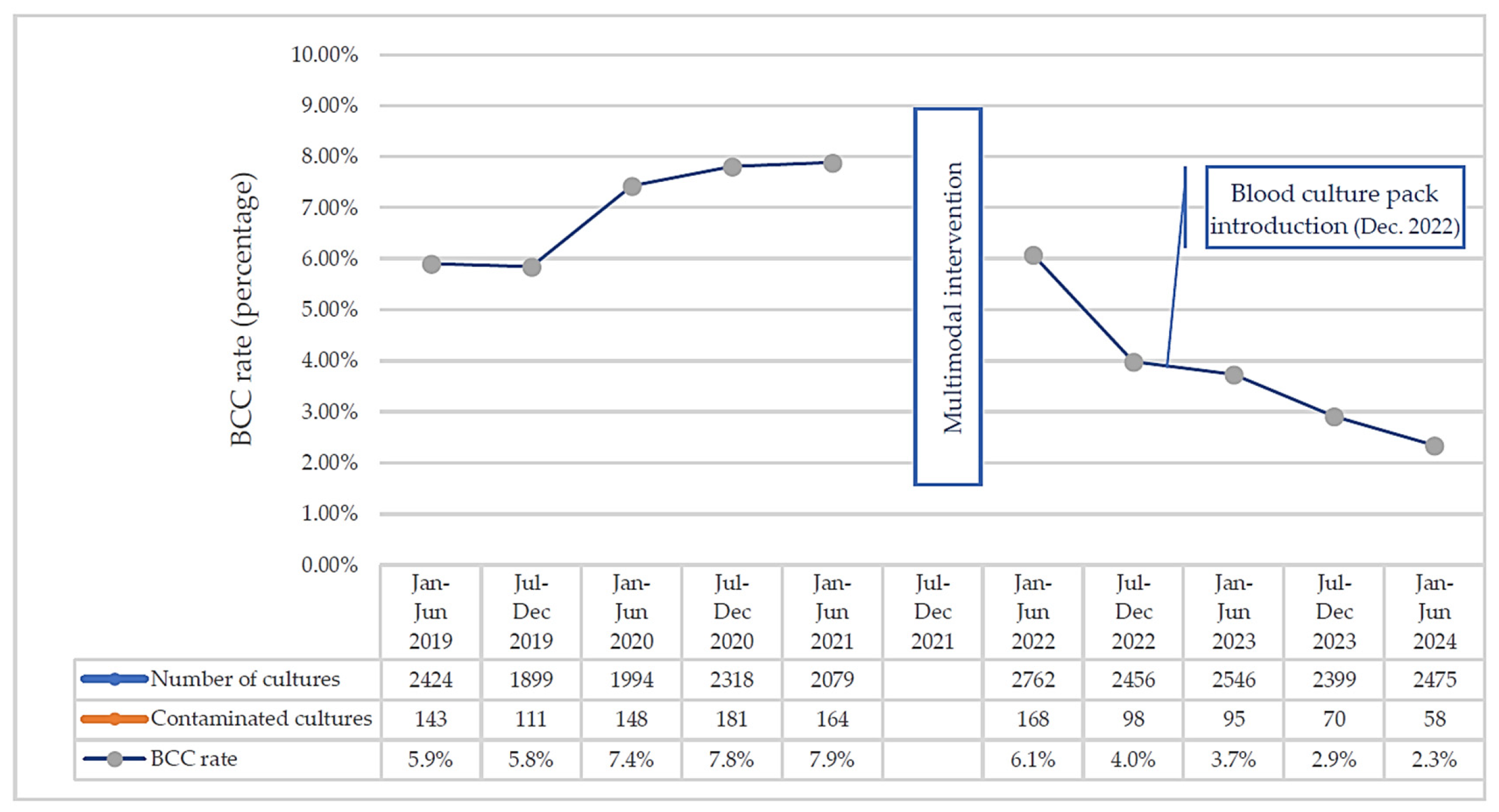Effectiveness of A Nurse-Led Multimodal Intervention in Preventing Blood Culture Contamination: A Before-and-After Study
Abstract
1. Introduction
2. Materials and Methods
2.1. Design
2.2. Sample
2.3. Intervention Overview
- Before blood draw: (1) confirm patient’s identification, explain the rationale for the procedure, and obtain consent; (2) perform hand hygiene with hand rub solution (73.4 g ethanol and 10.0 g propan-2-ol); (3) assemble necessary material to avoid further interruptions during the procedure; (4) verify the bottles’ expiry date and bottoms’ color to ensure the culture quality; (5) clean the work surface; (6) perform hand hygiene with hand rub solution (73.4 g ethanol and 10.0 g propan-2-ol); (7) prepare the material on a sterile drape; (8) remove the bottle caps, disinfect the top with 2% Chlorhexidine in 70% alcohol, and allow it to dry;
- During blood draw: (1) apply a single use tourniquet; (2) perform skin antisepsis with 2% Chlorhexidine in 70% alcohol and allow it to dry; (3) perform hand hygiene with hand rub solution (73.4 g ethanol and 10.0 g propan-2-ol), and put on sterile gloves; (4) perform phlebotomy with a Safety S-Monovette® needle and connect the membrane adapter to a 20 mL syringe (closed blood culture system); (5) pinch each culture bottle with one S-Monovette® safety needle and adapt the syringe, inoculating 10mL of blood in each culture bottle;
- After blood draw: (1) clearly identify the culture bottles; (2) send the culture bottles to the laboratory within 1 h; (3) document the procedure in patient’s health record.
- 1 blood culture set (1 aerobic bottle, BacT/ALERT FA, and 1 anaerobic bottle, BacT/ALERT FN; for children, 1 bottle BacT/ALERT PF);
- 2 sterile gauze 5 cm × 5 cm packages;
- 1 sterile drape;
- 1 clean drape;
- 3 S-Monovette® safety needles (SARSTEDT, Nümbrecht, Germany);
- 1 Safety-Multifly® needle (SARSTEDT);
- 1 Multi-adapter, Luer (SARSTEDT);
- 1 Membrane adapter (SARSTEDT);
- 1 sterile 20 mL syringe;
- 1 single-use tourniquet;
- 1 sterile dressing;
- 1 leaflet with the blood culture steps.
- System change (build it): improved use of available resources and the introduction of a blood culture pack;
- Training and education (teach it): the issue of BCC rates was discussed with the head nurses and IPC link nurses. In collaboration with the Microbiology Department, a comprehensive training program for nurses was devised and implemented;
- Monitoring and feedback (check it): the BCC rate was monitored, and feedback was provided on a quarterly basis;
- Reminders and communication (sell it): institutional guidelines were revised and disseminated in written format, as a poster format, and in a three-minute video;
- Culture change (live it): The IPC link nurse’s role was to disseminate the procedure for blood culture sampling and ensure its sustainability. The IPC lead nurse was present throughout the duration of the project, continuously accompanying the ward nurses.
2.4. Statistical Analysis
3. Results
4. Discussion
Limitations
5. Conclusions
Supplementary Materials
Author Contributions
Funding
Institutional Review Board Statement
Informed Consent Statement
Data Availability Statement
Acknowledgments
Conflicts of Interest
References
- O’Neill, J. Tackling Drug-Resistant Infections Globally: Final Report and Recommendations—The Review on Antimicrobial Resistance; CABI Digital Library: Wallingford, UK, 2016. [Google Scholar]
- Centers for Disease Control and Prevention. Preventing Adult Blood Culture Contamination: A Quality Tool for Clinical Laboratory Professionals; Centers for Disease Control and Prevention: Atlanta, GA, USA, 2024. [Google Scholar]
- Centers for Disease Control and Prevention. Blood Culture Contamination: An Overview for Infection Control and Antibiotic Stewardship Programs Working with the Clinical Laboratory; Centers for Disease Control and Prevention: Atlanta, GA, USA, 2024. [Google Scholar]
- Doern, G.V.; Carroll, K.C.; Diekema, D.J.; Garey, K.W.; Rupp, M.E.; Weinstein, M.P.; Sexton, D.J. Practical Guidance for Clinical Microbiology Laboratories: A Comprehensive Update on the Problem of Blood Culture Contamination and a Discussion of Methods for Addressing the Problem. Clin. Microbiol. Rev. 2019, 33, e00009-19. [Google Scholar] [CrossRef]
- Hoffmann, T.C.; Glasziou, P.P.; Boutron, I.; Milne, R.; Perera, R.; Moher, D.; Altman, D.G.; Barbour, V.; Macdonald, H.; Johnston, M.; et al. Better Reporting of Interventions: Template for Intervention Description and Replication (TIDieR) Checklist and Guide. BMJ 2014, 348, g1687. [Google Scholar] [CrossRef]
- Schinkel, M.; Boerman, A.; Carroll, K.; Cosgrove, S.E.; Hsu, Y.-J.; Klein, E.; Nanayakkara, P.; Schade, R.; Wiersinga, W.J.; Fabre, V. Impact of Blood Culture Contamination on Antibiotic Use, Resource Utilization, and Clinical Outcomes: A Retrospective Cohort Study in Dutch and US Hospitals. Open Forum Infect. Dis. 2023, 11, ofad644. [Google Scholar] [CrossRef] [PubMed]
- Bates, D.W.; Goldman, L.; Lee, T.H. Contaminant Blood Cultures and Resource Utilization: The True Consequences of False-Positive Results. JAMA 1991, 265, 365–369. [Google Scholar] [CrossRef] [PubMed]
- Lee, C.C.; Lin, W.J.; Shih, H.I.; Wu, C.J.; Chen, P.L.; Lee, H.C.; Lee, N.Y.; Chang, C.M.; Wang, L.R.; Ko, W.C. Clinical Significance of Potential Contaminants in Blood Cultures among Patients in a Medical Center. J. Microbiol. Immunol. Infect. 2007, 40, 438–444. [Google Scholar]
- Denno, J.; Gannon, M. Practical Steps to Lower Blood Culture Contamination Rates in the Emergency Department. J. Emerg. Nurs. 2013, 39, 459–464. [Google Scholar] [CrossRef] [PubMed]
- Park, W.B.; Myung, S.J.; Oh, M.-D.; Lee, J.; Kim, N.-J.; Kim, E.-C.; Park, J.S. Educational Intervention as an Effective Step for Reducing Blood Culture Contamination: A Prospective Cohort Study. J. Hosp. Infect. 2015, 91, 111–116. [Google Scholar] [CrossRef] [PubMed]
- Kumthekar, I.; Urs, T.; Rajashekar, D.; Karthik, K. Effectiveness of Multimodal Intervention to Improve Blood Culture Collection in a Tertiary Care Hospital. Cureus 2024, 16, e53941. [Google Scholar] [CrossRef]
- Dempsey, C.; Skoglund, E.; Muldrew, K.L.; Garey, K.W. Economic Health Care Costs of Blood Culture Contamination: A Systematic Review. Am. J. Infect. Control 2019, 47, 963–967. [Google Scholar] [CrossRef]
- Centers for Disease Control and Prevention. Hospital Sepsis Program Core Elements: 2023; Centers for Disease Control and Prevention: Atlanta, GA, USA, 2023. [Google Scholar]
- Manning, M.L.; Pogorzelska-Maziarz, M.; Hou, C.; Vyas, N.; Kraemer, M.; Carter, E.; Monsees, E. A Novel Framework to Guide Antibiotic Stewardship Nursing Practice. Am. J. Infect. Control 2022, 50, 99–104. [Google Scholar] [CrossRef]
- Dyar, O.J.; Huttner, B.; Schouten, J.; Pulcini, C. What Is Antimicrobial Stewardship? Clin. Microbiol. Infect. 2017, 23, 793–798. [Google Scholar] [CrossRef] [PubMed]
- Bowen, C.M.; Coleman, T.; Cunningham, D. Reducing Blood Culture Contaminations in the Emergency Department: It Takes a Team. J. Emerg. Nurs. 2016, 42, 306–311. [Google Scholar] [CrossRef] [PubMed]
- Cervero, M.; Quevedo, S.; del Álamo, M.; del Valle, P.; Wilhelmi, I.; Torres, R.; Agud, J.L.; Alcázar, V.; Vázquez, S.; García, B. Efficacy of an Information System Addressed to Nursing Staff for Diminishing Contaminated Blood Cultures: A Blind Clinical Trial. Rev. Esp. Quim. 2019, 32, 130–136. [Google Scholar]
- Chang, C.-J.; Wu, C.-J.; Hsu, H.-C.; Wu, C.-H.; Shih, F.-Y.; Wang, S.-W.; Wu, Y.-H.; Chang, C.-M.; Tu, Y.-F.; Chi, C.-H.; et al. Factors Associated with Blood Culture Contamination in the Emergency Department: Critical Illness, End-Stage Renal Disease, and Old Age. PLoS ONE 2015, 10, e0137653. [Google Scholar] [CrossRef]
- He, M.; Huang, S.; Xiong, J.; Xiao, Q. Improving Adherence to Facility Protocol and Reducing Blood Culture Contamination in an Intensive Care Unit: A Quality Improvement Project. Aust. Crit. Care 2020, 33, 546–552. [Google Scholar] [CrossRef]
- Sánchez-Sánchez, M.M.; Arias-Rivera, S.; Fraile-Gamo, P.; Jareño-Collado, R.; López-Román, S.; Vadillo-Obesso, P.; García-González, S.; Pulido-Martos, M.T.; Sánchez-Muñoz, E.I.; Cacho-Calvo, J.; et al. Effect of a training programme on blood culture contamination rate in critical care. Enferm. Intensiv. 2018, 29, 121–127. [Google Scholar] [CrossRef]
- Roth, A.; Wiklund, A.E.; Pålsson, A.S.; Melander, E.Z.; Wullt, M.; Cronqvist, J.; Walder, M.; Sturegård, E. Reducing Blood Culture Contamination by a Simple Informational Intervention. J. Clin. Microbiol. 2010, 48, 4552–4558. [Google Scholar] [CrossRef]
- Dhillon, R.H.-P.; Clark, J.; Azadian, B.S. Reducing Blood Culture Contamination. J. Hosp. Infect. 2009, 73, 97–99. [Google Scholar] [CrossRef]
- Self, W.H.; Talbot, T.R.; Paul, B.R.; Collins, S.P.; Ward, M.J. Cost Analysis of Strategies to Reduce Blood Culture Contamination in the Emergency Department: Sterile Collection Kits and Phlebotomy Teams. Infect. Control Hosp. Epidemiol. 2014, 35, 1021–1028. [Google Scholar] [CrossRef] [PubMed]
- World Health Organization. Guidelines on Core Components of Infection Prevention and Control Programmes at the National and Acute Health Care Facility Level; World Health Organization: Geneva, Switzerland, 2016; ISBN 978-92-4-154992-9. [Google Scholar]
- Bool, M.; Barton, M.J.; Zimmerman, P.-A. Blood Culture Contamination in the Emergency Department: An Integrative Review of Strategies to Prevent Blood Culture Contamination. Australas. Emerg. Care 2020, 23, 157–165. [Google Scholar] [CrossRef]
- Bekeris, L.G.; Tworek, J.A.; Walsh, M.K.; Valenstein, P.N. Trends in Blood Culture Contamination: A College of American Pathologists Q-Tracks Study of 356 Institutions. Arch. Pathol. Lab. Med. 2005, 129, 1222–1225. [Google Scholar] [CrossRef] [PubMed]
- Gesser-Edelsburg, A.; Cohen, R.; Halavi, A.M.; Zemach, M.; van Heerden, P.V.; Sviri, S.; Benenson, S.; Trahtemberg, U.; Orenbuch-Harroch, E.; Lowenstein, L.; et al. Beyond the Hospital Infection Control Guidelines: A Qualitative Study Using Positive Deviance to Characterize Gray Areas and to Achieve Efficacy and Clarity in the Prevention of Healthcare-Associated Infections. Antimicrob. Resist. Infect. Control 2018, 7, 124. [Google Scholar] [CrossRef]
- Irvine, D.; Sidani, S.; Hall, L.M. Finding Value in Nursing Care: A Framework for Quality Improvement and Clinical Evaluation. Nurs. Econ. 1998, 16, 110–116, 131. [Google Scholar] [PubMed]
- Alahmadi, Y.M.; Aldeyab, M.A.; McElnay, J.C.; Scott, M.G.; Darwish Elhajji, F.W.; Magee, F.A.; Dowds, M.; Edwards, C.; Fullerton, L.; Tate, A.; et al. Clinical and Economic Impact of Contaminated Blood Cultures within the Hospital Setting. J. Hosp. Infect. 2011, 77, 233–236. [Google Scholar] [CrossRef]
- Su, G. A Collaborative Approach to Reduce Healthcare-Associated Infections. Br. J. Nurs. 2016, 25, 582–586. [Google Scholar] [CrossRef] [PubMed]
- Ara, L.; Bashar, F.; Tamal, M.E.H.; Siddiquee, N.K.A.; Mowla, S.M.N.; Sarker, S.A. Transferring Knowledge into Practice: A Multi-Modal, Multi-Centre Intervention for Enhancing Nurses’ Infection Control Competency in Bangladesh. J. Hosp. Infect. 2019, 102, 234–240. [Google Scholar] [CrossRef] [PubMed]
- Eckmanns, T.; Bessert, J.; Behnke, M.; Gastmeier, P.; Ruden, H. Compliance with Antiseptic Hand Rub Use in Intensive Care Units: The Hawthorne Effect. Infect. Control Hosp. Epidemiol. 2006, 27, 931–934. [Google Scholar] [CrossRef]
- Elia, F.; Calzavarini, F.; Bianco, P.; Vecchietti, R.G.; Macor, A.F.; D’Orazio, A.; Dragonetti, A.; D’Alfonso, A.; Belletrutti, L.; Floris, M.; et al. A Nudge Intervention to Improve Hand Hygiene Compliance in the Hospital. Intern. Emerg. Med. 2022, 17, 1899–1905. [Google Scholar] [CrossRef]
- CDC. The Core Elements of Hospital Antibiotic Stewardship Programs; CDC: Atlanta, GA, USA, 2019. [Google Scholar]
- Olans, R.N.; Olans, R.D.; DeMaria, A., Jr. The Critical Role of the Staff Nurse in Antimicrobial Stewardship—Unrecognized, but Already There. Clin. Infect. Dis. 2016, 62, 84–89. [Google Scholar] [CrossRef]
- Doran, D.M.; Harrison, M.B.; Laschinger, H.S.; Hirdes, J.P.; Rukholm, E.; Sidani, S.; Hall, L.M.; Tourangeau, A.E. Nursing-Sensitive Outcomes Data Collection in Acute Care and Long-Term-Care Settings. Nurs. Res. 2006, 55, S75–S81. [Google Scholar] [CrossRef]
- Moeller, D. Eliminating Blood Culture False Positives: Harnessing the Power of Nursing Shared Governance. J. Emerg. Nurs. 2017, 43, 126–132. [Google Scholar] [CrossRef] [PubMed]
- Van Buijtene, A.; Foster, D. Does a Hospital Culture Influence Adherence to Infection Prevention and Control and Rates of Healthcare Associated Infection? A Literature Review. J. Infect. Prev. 2019, 20, 5–17. [Google Scholar] [CrossRef] [PubMed]



| Phase 1 | Phase 2 | |||
|---|---|---|---|---|
| 1 January 2019–16 June 2021 | Moment 1 1 | Moment 2 2 | Moment 1 and Moment 2 | |
| 1 January 2022–31 June 2022 | 1 January 2023–16 June 2024 | |||
| Total number of cultures | 10,928 | 5218 | 7420 | 12,638 |
| Contaminated cultures | 741 | 266 | 223 | 489 |
| BCC rate | 6.80% | 5.10% | 3.00% | 3.90% |
| Multimodal Intervention 1 Phase 1 and Phase 2 | After Multimodal Intervention 2 Moment 1 and Moment 2 | |||||
|---|---|---|---|---|---|---|
| Before | After | p Value | Before | After | p Value 3 | |
| Set 1 culture 1 M(SD) culture 2 M(SD) | 0.07 (0.25) | 0.03 (0.18) | <0.001 | 0.06 (0.23) | 0.02 (0.013) | <0.001 |
| 0.08 (0.27) | 0.04 (0.20) | <0.001 | 0.06 (0.24) | 0.03 (0.17) | <0.001 | |
| Set 2 culture 1 M(SD) culture 2 M(SD) | 0.07 (0.25) | 0.05 (0.21) | 0.004 | 0.06 (0.24) | 0.03 (0.18) | 0.001 |
| 0.07 (0.26) | 0.05 (0.21) | <0.001 | 0.06 (0.23) | 0.04 (0.19) | 0.018 | |
| Set 3 culture 1 M(SD) culture 2 M(SD) | 0.07 (0.26) | 0.04 (0.20) | 0.008 | 0.05 (0.21) | 0.04 (0.19) | 0.597 |
| 0.07 (0.25) | 0.05 (0.21) | 0.028 | 0.05 (0.22) | 0.05 (0.21) | 0.779 | |
| Multimodal Intervention 1 Phase 1 (1 January 2019/16 June 2021) and Phase 2 (1 January 2022/16 June 2024) | Blood Culture Pack 2 Phase 1 (1 January 2019/15 June 2021) and M 2 (1 January 2023/16 June 2024) | After Multimodal Intervention 3 M 1 (1 January 2022/31 December 2022) and M 2 (1 January 2023/15 June 2024) | |||||
|---|---|---|---|---|---|---|---|
| OR | IC95% | OR | IC95% | OR | IC95% | ||
| Set 1 | Culture1 | 2.23 | 1.77–2.80 | 3.97 | 2.86–5.49 | 3.49 | 2.40–5.07 |
| Culture 2 | 1.98 | 1.55–2.54 | 2.69 | 1.92–3.75 | 2.17 | 1.46–3.23 | |
| Set 2 | Culture 3 | 1.46 | 1.13–1.89 | 1.97 | 1.43–2.72 | 1.90 | 1.30–2.79 |
| Culture 4 | 1.69 | 1.31–2.17 | 1.94 | 1.42–2.66 | 1.61 | 1.09–2.36 | |
| Set 3 | Culture 5 | 1.72 | 1.14–2.58 | 1.67 | 1.03–2.70 | 1.19 | 0.62–2.31 |
| Culture 6 | 1.55 | 1.04–2.30 | 1.47 | 0.93–2.32 | 1.10 | 0.58–2.06 | |
Disclaimer/Publisher’s Note: The statements, opinions and data contained in all publications are solely those of the individual author(s) and contributor(s) and not of MDPI and/or the editor(s). MDPI and/or the editor(s) disclaim responsibility for any injury to people or property resulting from any ideas, methods, instructions or products referred to in the content. |
© 2024 by the authors. Licensee MDPI, Basel, Switzerland. This article is an open access article distributed under the terms and conditions of the Creative Commons Attribution (CC BY) license (https://creativecommons.org/licenses/by/4.0/).
Share and Cite
Filipe, S.; Martins, T.; Santos-Costa, P.; Paiva-Santos, F.; Castilho, A.; Bastos, C. Effectiveness of A Nurse-Led Multimodal Intervention in Preventing Blood Culture Contamination: A Before-and-After Study. Healthcare 2024, 12, 1735. https://doi.org/10.3390/healthcare12171735
Filipe S, Martins T, Santos-Costa P, Paiva-Santos F, Castilho A, Bastos C. Effectiveness of A Nurse-Led Multimodal Intervention in Preventing Blood Culture Contamination: A Before-and-After Study. Healthcare. 2024; 12(17):1735. https://doi.org/10.3390/healthcare12171735
Chicago/Turabian StyleFilipe, Susana, Teresa Martins, Paulo Santos-Costa, Filipe Paiva-Santos, Amélia Castilho, and Celeste Bastos. 2024. "Effectiveness of A Nurse-Led Multimodal Intervention in Preventing Blood Culture Contamination: A Before-and-After Study" Healthcare 12, no. 17: 1735. https://doi.org/10.3390/healthcare12171735
APA StyleFilipe, S., Martins, T., Santos-Costa, P., Paiva-Santos, F., Castilho, A., & Bastos, C. (2024). Effectiveness of A Nurse-Led Multimodal Intervention in Preventing Blood Culture Contamination: A Before-and-After Study. Healthcare, 12(17), 1735. https://doi.org/10.3390/healthcare12171735








